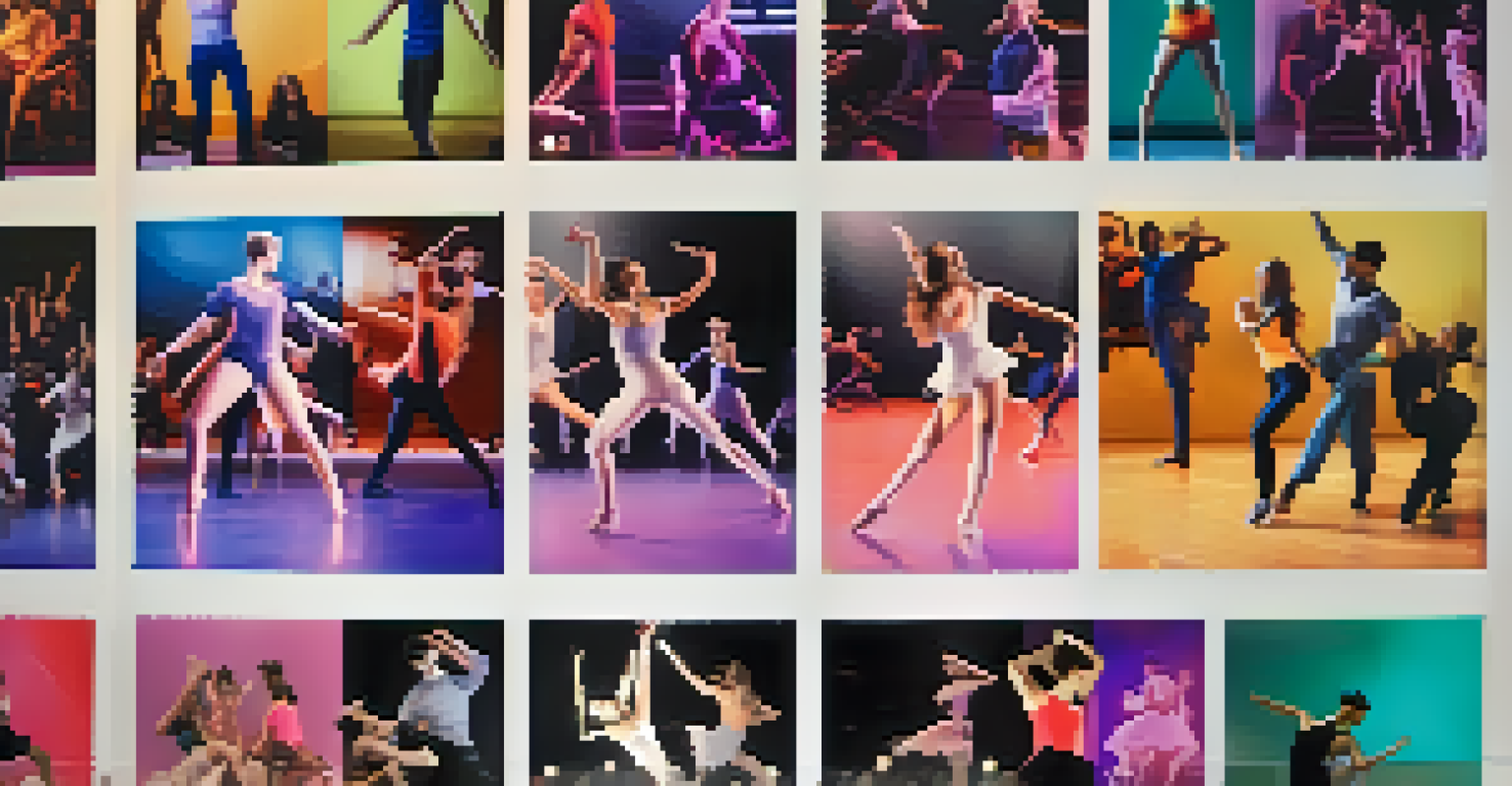Critics as Influencers: Shaping Dance Perception Today

Understanding the Role of Dance Critics
Dance critics play a vital role in shaping the public's perception of dance by providing insights and evaluations of performances. Their opinions can highlight the nuances of a dancer's technique, the creativity behind choreography, and even the emotional impact of a piece. This scrutiny not only informs audiences but also serves as a vital feedback mechanism for artists themselves.
Criticism is a way of engaging with art that can lead to deeper understanding and appreciation.
Historically, critics wielded considerable power, often determining which performances gained popularity and which faded into obscurity. Their reviews could elevate a dancer's career or tarnish a choreographer's reputation. In this sense, critics have always been influencers, guiding audiences and the industry alike towards what is deemed worthy of attention.
In recent years, the digital age has reshaped how critics share their thoughts, allowing them to reach larger audiences through blogs, social media, and video platforms. This shift has democratized dance criticism, enabling more voices to join the conversation and offering diverse perspectives that enrich the dance community.
The Evolution of Dance Criticism
Dance criticism has evolved alongside the art form itself, adapting to cultural shifts and new movements. In the past, traditional reviews were often steeped in formal language and strict criteria, which could alienate general audiences. Today, however, many critics embrace a more conversational style, making their insights accessible and relatable.

For instance, the rise of street dance and contemporary styles has prompted critics to broaden their vocabulary and understandings of what dance can be. As these genres gain popularity, critics now assess performances not just on technique but also on emotional resonance, storytelling, and cultural context. This evolution encourages a more inclusive approach to dance evaluation.
Dance Critics Shape Public Perception
Dance critics provide valuable insights that influence both audience opinions and the careers of dancers and choreographers.
Furthermore, critics are increasingly engaging with audiences through interactive platforms, inviting readers to share their experiences and opinions. This two-way communication fosters a sense of community and allows for a richer dialogue around dance, emphasizing that criticism is not just about judgment, but also about connection.
Impact of Social Media on Dance Criticism
Social media has transformed the landscape of dance criticism, allowing critiques to be shared instantly with a global audience. Platforms like Instagram, TikTok, and Twitter enable critics to share short reviews, video snippets, and even live commentary, creating a dynamic conversation around performances. This immediacy can amplify a dancer's reach and impact almost overnight.
Art is not freedom from discipline, but disciplined freedom.
However, the rapid pace of social media can also lead to oversimplified critiques, where nuanced opinions are distilled into catchy hashtags or soundbites. While this grabs attention, it risks reducing the depth of analysis that traditional reviews provided. Critics must strike a balance between engaging audiences and preserving the integrity of their evaluations.
Moreover, the accessibility of social media means that anyone can become a critic, leading to a diverse array of voices contributing to the conversation. This democratization allows for a broader spectrum of opinions, which can enrich the community but also introduces challenges in discerning credible critiques from mere noise.
The Power of Reviews in Shaping Trends
Reviews from prominent critics can significantly influence dance trends, often dictating what styles or performances gain traction within the industry. A glowing review can catapult a relatively unknown artist into the limelight, while harsh critiques can discourage innovation and deter audiences from exploring new works. This power underscores the responsibility critics hold in their assessments.
For example, when a respected critic praises a particular dance festival or company, it can lead to increased ticket sales and heightened interest in those performances. This ripple effect not only benefits the artists involved but also enriches the cultural landscape by encouraging more diverse offerings. Critics essentially become gatekeepers, influencing which narratives are told through dance.
Social Media's Impact on Criticism
The rise of social media has democratized dance criticism, allowing a broader range of voices to contribute while also challenging the depth of analysis.
As trends shift, critics must also adapt their perspectives, recognizing the evolving landscape of dance and the emerging voices within it. This adaptability ensures that their critiques remain relevant and engaging, fostering an environment where innovation can thrive and audiences are continually inspired.
Critics vs. Audience Perspectives
While critics provide informed opinions based on their expertise, audience perspectives are equally valid and important in the dance ecosystem. The emotional responses of viewers can sometimes diverge from critical assessments, highlighting a disconnect between technical evaluation and personal enjoyment. This variance enriches the conversation around dance, emphasizing that art is subjective.
For instance, a performance that receives a lukewarm critical response may resonate deeply with audiences who connect with its themes or emotions. This phenomenon serves as a reminder that dance, at its core, is about human experience and connection. Critics should not only share their insights but also consider and respect the diverse reactions of the audience.
Encouraging dialogue between critics and audiences can foster a deeper understanding of dance. Critics who engage with audience feedback can refine their perspectives and contribute to a more holistic view of a performance, ultimately benefiting both the artists and the viewers.
Diversity in Dance Criticism
The landscape of dance criticism is becoming increasingly diverse, with critics from various backgrounds offering fresh perspectives. This shift is crucial as it allows for a more comprehensive understanding of the art form, reflecting the multifaceted nature of dance itself. Diverse voices can challenge traditional narratives and bring attention to underrepresented artists and styles.
For example, critics who specialize in cultural dance forms can provide insights that mainstream critics may overlook. Their expertise helps to illuminate the significance of these dances within their cultural contexts, fostering appreciation and respect. This not only enriches the dance community but also encourages broader audiences to explore and embrace a variety of dance forms.
Diversity Enriches Dance Criticism
An increasingly diverse group of critics brings fresh perspectives that highlight underrepresented artists and styles within the dance community.
Moreover, as the conversation around diversity expands, so too does the responsibility of critics to educate themselves and consider the implications of their words. By actively seeking out diverse perspectives and representations, critics can help to shape a more inclusive dialogue around dance, ensuring that all voices are heard and valued.
The Future of Dance Criticism
As the world of dance continues to evolve, so too will the role of critics within it. The rise of digital platforms and the increasing demand for varied content will likely lead to more innovative forms of criticism, such as video essays and interactive critiques. This evolution presents exciting opportunities for critics to engage with audiences in dynamic ways, enhancing the overall experience of dance.
Furthermore, as dance becomes more integrated into popular culture, critics may find themselves exploring new genres and styles that challenge traditional norms. The blending of different art forms will require critics to broaden their understanding and adapt their evaluative frameworks, ensuring they remain relevant in a rapidly changing landscape.

Ultimately, the future of dance criticism hinges on the ability to foster genuine connection and dialogue. By prioritizing engagement with audiences and embracing diverse perspectives, critics can continue to play a vital role in shaping the perception of dance for years to come.